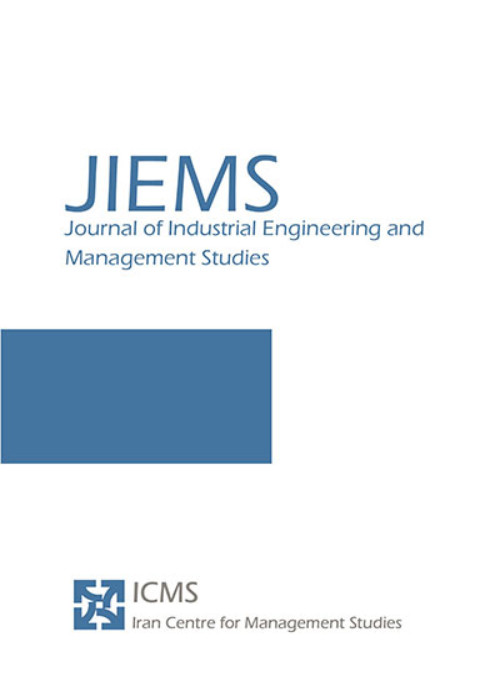فهرست مطالب
Journal of Industrial Engineering and Management Studies
Volume:2 Issue: 1, Winter-Spring 2015
- تاریخ انتشار: 1394/09/09
- تعداد عناوین: 6
-
-
Pages 1-15Fuzzy reliability is often used in analyzing the reliability in the large industrial systems. In this paper, a relatively new method is presented to analyze Neishabour (also called Nishapur, a city in Iran) train disaster. In this regards, by using the certain and uncertain propositions, unreliability circuit of the system is depicted. Due to the inability to provide exact values for the unreliability of each subsystem, regarding the opinion of experts, fuzzy logic is applied and triangular and Gaussian membership functions are attributed depending to the type of each subsystem and the fuzzy unreliability value of the system is calculated. Finally, by defuzzification and comparing the obtained value with the classification table of linguistic variables, unreliability of the system is identified.Keywords: Fuzzy Reliability, Triangular Membership Function, Gaussian Membership Function, Neishabour train disaster, α, cut
-
Pages 16-26This paper, considers Network Failure Manufacturing System (NFPMS) and production control policy of unreliable multi-machines, multi-products with perishable items. The production control policy is based on the Hedging Point Policy (HPP). The important point in the simulation of this system is assumed that the customers who receive perishable item are placed in priority queue of the customers who are faced with shortage. The main goal of this paper is determining of optimal production rates that minimizes average total cost consist of shortage, production, holding and perishable costs. Because of uncertainly and complexity of this system, simulation optimization of this system using ARENA software has been done. A numerical example will show the efficiency of the proposed approach.Keywords: FPMS, Perishable items, Simulation modeling, production planning, Taguchi design of experiment
-
Pages 27-40This paper considers a three-stage fixed charge transportation problem regarding stochastic demand and price. The objective of the problem is to maximize the profit for supplying demands. Three kinds of costs are presented here: variable costs that are related to amount of transportation cost between a source and a destination. Fixed charge exists whenever there is a transfer from a source to a destination, and finally, shortage cost that incurs when the manufacturer does not have enough products for supplying customer’s demand. The model is formulated as a mixed integer programming problem and is solved using a multicriteria scenario based solution approach to find the optimal solution. Mean, standard deviation, and coefficient of variation are compared as the acceptable criteria to decide about the best solution.Keywords: Fixed charge transportation problem, stochastic optimization, multi, criteria scenario, based solution, mean, standard deviation, coefficient of variation
-
Pages 41-60Here, a collection of base functions and sub-functions configure the nodes of a web-based (digital)network representing functionalities. Each arc in the network is to be assigned as the link between two nodes. The aim is to find an optimal tree of functionalities in the network adding value to the product in the web environment. First, a purification process is performed in the product network to assign the links among bases and sub-functions. Then, numerical values as benefits and costs are determined for arcs and nodes, respectively. To handle the bi-objective Steiner tree, a particle swarm optimization algorithm is adapted to find the optimal tree determining the value adding sub-functions to bases in a convergent product. An example is worked out to illustrate the applicability of the proposed approach.Keywords: Convergent product, Web, based (digital) network, Bi, objective programming, Steiner tree, Particle Swarm Optimization (PSO)
-
Pages 61-73In this paper, a new mathematical model for the problem of job scheduling in virtual manufacturing cells (VMC) is presented to minimizing the completion time of all jobs. Sequence dependent setup times of machines is considered and lot-streaming is possible. In Virtual manufacturing cells, each job has a different processing path and there is a set of machines for processing each operation. There are multiple machine types with several identical machines in each type locating in different locations in the shop floor. In this type of system, the cells are not physical and Machines can be shared between the cells. In Mixed-integer nonlinear programming model presented, the scheduling decisions involve assigning a machine to each operation, the start time at each operation, the start time of machines and sub-lot sizes of each job. Some test problems have been generated to demonstrate the implementation of the model and solved by Lingo.Keywords: virtual manufacturing cells, Scheduling, lot, streaming, Mathematical model, integer programming
-
Pages 74-94Iranian bread production methods are often unsanitary, in the last decades, different attempts were made to mechanize production of Iranian breads, but a few of them, due to a variety of factors, could succeed. The aim of this study is to examine various factors affecting the system of bread production in Iran and to provide effective solutions for the development of mechanized bakeries as the main strategy for improving the quality of bread production. Existence of different factors and the relation between them makes the system of bread production a complex system; therefore, this study uses system dynamics approach to analyze this system and to design solutions. Furthermore, the system of bread production is broken down to three subsystems: knowledge and technology subsystem, economic subsystem, and political and social subsystem.Keywords: System analysis, system dynamics, mechanized bakeries, bread supply chain


